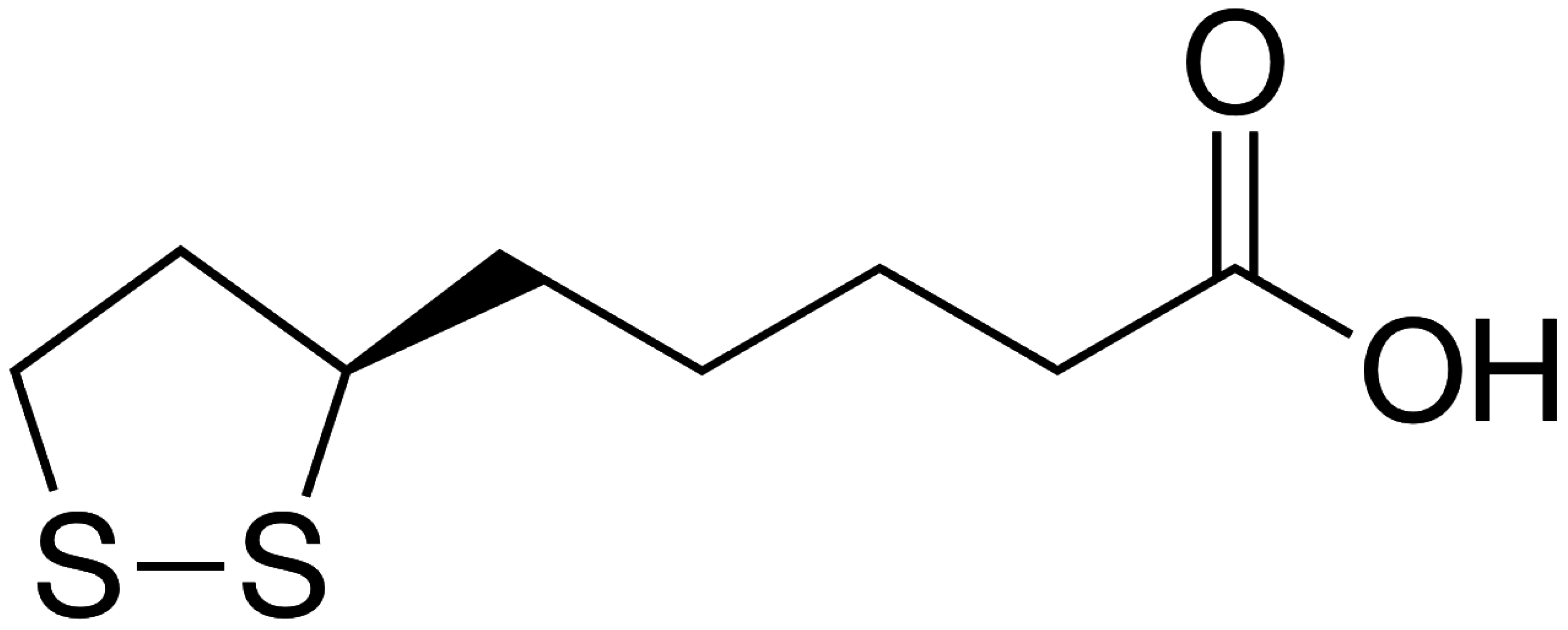Effect of Oral Alpha Lipoic Acid in Preventing the Genesis of Canine Diabetic Cataract: A Preliminary Study
Abstract
:1. Introduction
2. Materials and Methods
3. Results
4. Discussion
5. Conclusions
Supplementary Materials
Acknowledgments
Conflicts of Interest
References
- Basher, A.W.; Roberts, S.M. Ocular manifestations of diabetes mellitus: Diabetic cataracts in dogs. Vet. Clin. North Am. Small Anim. Pract. 1995, 25, 661–676. [Google Scholar] [CrossRef]
- Varma, S.D. Aldose reductase and the etiology of diabetic cataracts. Curr. Top. Eye Res. 1980, 3, 91–155. [Google Scholar] [PubMed]
- Kinoshito, J.H. Pathways of glucose metabolism in the lens. Investig. Ophthalmol. Vis. Sci. 1965, 4, 619–628. [Google Scholar]
- Hejtmancik, J.F.; Riazuddin, S.A.; McGreal, R.; Liu, W.; Cvekl, A.; Shiels, A. Lens Biology and Biochemistry. Prog. Mol. Biol. Transl. Sci. 2015, 134, 169–201. [Google Scholar] [PubMed]
- Sato, S.; Takahashi, Y.; Wyman, M.; Kador, P.F. Progression of sugar cataract in the dog. Investig. Ophthalmol. Vis. Sci. 1991, 32, 1925–1931. [Google Scholar]
- Hashim, Z.; Zarina, S. Advanced glycation end products in diabetic and non-diabetic human subjects suffering from cataract. Age 2011, 33, 377–384. [Google Scholar] [CrossRef] [PubMed]
- Williams, D.L. Oxidative stress and the eye. Vet. Clin. North Am. Small Anim. Pract. 2008, 38, 179–192. [Google Scholar] [CrossRef] [PubMed]
- Kador, P.F.; Webb, T.R.; Bras, D.; Ketring, K.; Wyman, M. Topical KINOSTAT™ ameliorates the clinical development and progression of cataracts in dogs with diabetes mellitus. Vet. Ophthalmol. 2010, 13, 363–368. [Google Scholar] [CrossRef] [PubMed]
- Kador, P.F.; Wyman, M.; Oates, P.J. Aldose reductase, ocular diabetic complications and the development of topical Kinostat(®). Prog. Retin. Eye Res. 2016, 54, 1–29. [Google Scholar] [CrossRef] [PubMed]
- Williams, D.; Fitchie, A.; Colitz, C. An Oral Antioxidant Formulation Delaying and Potentially Reversing Canine Diabetic Cataract: A Placebo-controlled Double-masked Pilot Study. Int. J. Diab. Clin. Res. 2015, 2, 1–5. [Google Scholar] [CrossRef]
- Zicker, S.C.; Hagen, T.M.; Joisher, N.; Golder, C.; Joshi, D.K.; Miller, E.P. Safety of long-term feeding of dl-alpha-lipoic acid and its effect on reduced glutathione:oxidized glutathione ratios in beagles. Vet. Ther. 2002, 3, 167–176. [Google Scholar] [PubMed]
- Busse, E.; Zimmer, G.; Schophl, B.; Kornhuber, B. Influence of alpha-lipoic acid on intracellular glutathione in vitro and in vivo. Arzneim.-Forsch. 1992, 42, 829–831. [Google Scholar]
- Kojima, M.; Sun, L.; Hata, I.; Sakamoto, Y.; Sasaki, H.; Sasaki, K. Efficacy of alpha-lipoic acid against diabetic cataract in rat. Jpn. J. Ophthalmol. 2007, 51, 10–13. [Google Scholar] [CrossRef] [PubMed]
- Kan, E.; Alici, Ö.; Kan, E.K.; Ayar, A. Effects of alpha-lipoic acid on retinal ganglion cells, retinal thicknesses, and VEGF production in an experimental model of diabetes. Int. Ophthalmol. 2016. [Google Scholar] [CrossRef] [PubMed]
- Beam, S.; Correa, M.T.; Davidson, M.G. A retrospective-cohort study on the development of cataracts in dogs with diabetes mellitus: 200 cases. Vet. Ophthalmol. 1999, 2, 169–172. [Google Scholar] [CrossRef] [PubMed]
- Brownlee, J.M.; Carlson, E.; Milne, A.C.; Pape, E.; Harrison, D.H. Structural and thermodynamic studies of simple aldose reductase-inhibitor complexes. Bioorg Chem. 2006, 34, 424–444. [Google Scholar] [CrossRef] [PubMed]
- Reljanovic, M.; Reichel, G.; Rett, K.; Lobisch, M.; Schuette, K.; Möller, W.; Tritschler, H.J.; Mehnert, H. Treatment of diabetic polyneuropathy with the antioxidant thioctic acid (alpha-lipoic acid): A two year multicenter randomized double-blind placebo-controlled trial (ALADIN II). Alpha Lipoic Acid in Diabetic Neuropathy. Free Radic Res. 1999, 31, 171–179. [Google Scholar] [CrossRef] [PubMed]
- Ziegler, D.; Gries, F.A. α-lipoic acid in the treatment of diabetic peripheral and cardiac autonomic neuropathy. Diabetes 1997, 46, S62–S66. [Google Scholar] [CrossRef] [PubMed]
- Kan, E.; Kiliçkan, E.; Ayar, A.; Çolak, R. Effects of two antioxidants: α lipoic acid and fisetin against diabetic cataracts in mice. Int. Ophthalmol. 2015, 35, 115–120. [Google Scholar] [CrossRef] [PubMed]
- Takamura, Y.; Tomomatsu, T.; Kubo, E.; Tsuzuki, S.; Akagi, Y. Role of the polyol pathway in high glucose-induced apoptosis of retinal pericytes and proliferation of endothelial cells. Investig. Ophthalmol. Vis. Sci. 2008, 49, 3216–3223. [Google Scholar] [CrossRef] [PubMed]
- Warwick, A.N.; Brooks, A.P.; Osmond, C.; Krishnan, R. Prevalence of referable, sight-threatening retinopathy in type 1 diabetes and its relationship to diabetes duration and systemic risk factors. Eye 2017, 31, 333–341. [Google Scholar] [CrossRef] [PubMed]
- Ou, P.; Nourooz-zadeh, J.; Tritschler, H.J.; Wolff, S. Activation of aldose reductase in rat lens and metal-ion chelation by aldose reductase inhibitors and lipoic acid. Free Radic. Res. 1996, 25, 337–346. [Google Scholar] [CrossRef] [PubMed]
- Richter, M.; Guscetti, F.; Spiess, B. Aldose reductase activity and glucose-related opacities in incubated lenses from dogs and cats. Am. J. Vet. Res. 2002, 63, 1591–1597. [Google Scholar] [CrossRef] [PubMed]
- Snow, A.; Shieh, B.; Chang, K.C.; Pal, A.; Lenhart, P.; Ammar, D.; Ruzycki, P.; Palla, S.; Reddy, G.B.; Petrash, J.M. Aldose reductase expression as a risk factor for cataract. Chem. Biol. Interact. 2015, 5, 247–253. [Google Scholar] [CrossRef] [PubMed]
- Lee, A.Y.; Chung, S.K.; Chung, S.S. Demonstration that polyol accumulation is responsible for diabetic cataract by the use of transgenic mice expressing the aldose reductase gene in the lens. Proc. Natl. Acad. Sci. USA 1995, 92, 2780–2784. [Google Scholar] [CrossRef] [PubMed]


© 2017 by the author. Licensee MDPI, Basel, Switzerland. This article is an open access article distributed under the terms and conditions of the Creative Commons Attribution (CC BY) license ( http://creativecommons.org/licenses/by/4.0/).
Share and Cite
Williams, D.L. Effect of Oral Alpha Lipoic Acid in Preventing the Genesis of Canine Diabetic Cataract: A Preliminary Study. Vet. Sci. 2017, 4, 18. https://doi.org/10.3390/vetsci4010018
Williams DL. Effect of Oral Alpha Lipoic Acid in Preventing the Genesis of Canine Diabetic Cataract: A Preliminary Study. Veterinary Sciences. 2017; 4(1):18. https://doi.org/10.3390/vetsci4010018
Chicago/Turabian StyleWilliams, David L. 2017. "Effect of Oral Alpha Lipoic Acid in Preventing the Genesis of Canine Diabetic Cataract: A Preliminary Study" Veterinary Sciences 4, no. 1: 18. https://doi.org/10.3390/vetsci4010018




